Simultaneous quantitation of fat-soluble vitamins in formula infant milk by LC-MS/MS
Ercui Ye; Nick Zhu
SCIEX, China
Abstract
Fat-soluble vitamins are essentials nutrient in infant formula milk, with minimum and maximum content requirements defined in CODEX STAN 72-1981. Here, an easy, comprehensive, high-throughput method for simultaneous determination for 8 fat-soluble vitamins using SCIEX QTRAP® 4500 System is presented.
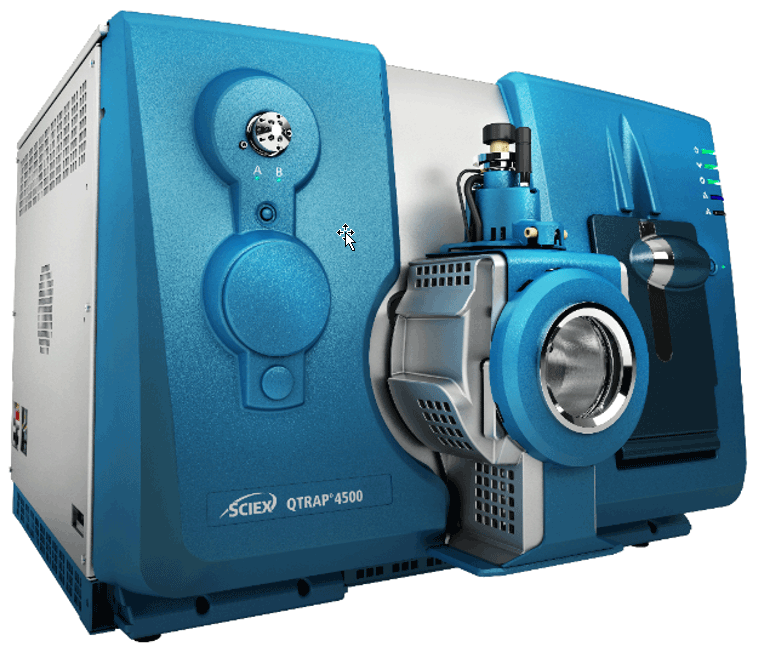
Introduction
Fat-soluble vitamins (lipid-soluble vitamins) are essential nutrients for infant food as they have important roles in several functions in the human body, such as vision (Vitamin A), calcium metabolism (Vitamin D), antioxidative protection in cell membranes (Vitamin E) and blood clot (Vitamin K). CODEX STAN 72-1981 contains minimum and maximum content requirements of fat-soluble vitamins in infant formula. Reliable, sensitive and rapid methods for measuring fat-soluble vitamins in infant formula are essential for nutritional reasons.
The chemical properties and levels of each of the vitamins in infant formula are different, which makes the simultaneous extraction and analysis of all vitamins extremely challenging. Over time, compendial methods have been developed and published by organizations such as AOAC INTERNATIONAL, the European Committee for Standardization, the International Dairy Federation, and the International Organization for Standardization, among others. In general, these methods have shown adequate precision for regulatory compliance. However, analysis of vitamins A, D, E and K1 require combined methods, making the process laborious and time consuming. Here, an easy, comprehensive, high-throughput method for simultaneous determination for 8 fat-soluble vitamins using SCIEX QTRAP 4500 System is presented.
Compared with AOAC 2012.10 and AOAC 2011.11 methods, which require large volume solvent of saponification, liquid and liquid extraction, this method provides simplified and developed sample preparation procedures (Figure 1). Both the saponification (digestion) and extraction step are carried out in a 15 mL plastic centrifuge tube without the need for separatory funnels and multiple, larger-volume extraction steps. Instead of extracting separately, the sample preparation method integrates vitamins A, E and vitamin D extraction, which considerably reduce the time required for sample preparation procedures and therefore increase the analytical throughput.
Figure 1. Simplification of method. (Top) Vitamins A, D, E, K sample preparation of AOAC Methods requires multiple steps. (Bottom) Vitamins A, D, E, K sample preparation of vMethod is significantly simplified.
Key benefits of LC-MS/MS method
- Simplified, high-throughput sample preparation method (Figure 1)
- Single LC-MS method to analyze 8 fat-soluble vitamins in 15 min with tocopherol isomers resolved from each other (Figure 2)
- Isotope-labeled internal standardization ensures the accuracy of reported concentration (Figure 3)
- Excellent sensitivity and adequate calibration range for regulatory compliance, which enable laboratories to analyze routine samples (Table 1)
- Compliance with CODEX STAN 72-1981 regulatory requirements
- The method proved to be reliable as results agreed with the sample’s labels with the permitted variation (Table 2)
Figure 2. Separation of 8 fat-soluble vitamin standards. (Top) Total chromatogram of separation is shown with the time axis zoomed in (bottom) so show the separation of the tocopherol isomers.
Results
In recent years, LC–MS shows great sensitivity and specificity for the determination of vitamins and permits the simultaneous analysis of multiple vitamins in a single analysis. According to AOAC methods, analysis of fat-soluble vitamins requires combination of several methods, such that the entire process is very cumbersome and time-consuming. Using SCIEX QTRAP 4500 System, 8 fat-soluble vitamins were successfully analyzed in 15 min, as seen in Figure 2. Four tocopherol isomers (α-tocopherol, β- tocopherol, γ- tocopherol, δ- tocopherol) were easily resolved using this separation method, shown in Figure 2 (bottom).
Figure 3. Recovery of 8 fat-soluble vitamins. Stable isotope internal standards are spiked into samples during sample preparation to correct for any losses, resulting in good accuracy.
Fat-soluble vitamins, especially for vitamins A and E, could be destroyed under the presence of oxygen, light, heat and storage time. During the extraction process, samples were always protected from direct exposition to light and protected by antioxidant to minimize degradation. Stable isotope-labeled internal standards are used in the method to correct significant reduction of vitamins degradation and matrix effect. Recoveries at both spiking levels were between 80.53% and 105.96%, which demonstrated excellent accuracy for this assay (Figure 3).
Calibration range, coefficients of determination and limits of quantitation (LOQ) of 8 fat-soluble vitamins are shown in Table 1.
Table 1. Performance data of 8 fat-soluble vitamins analyzed.
Two commercial infant formulas were obtained and tested using the method. Good agreement was observed between the results obtained with this method and the sample’s labels (Table 2).
Table 2. Measured amount of fat-soluble vitamins in commercial infant formulas.
Conclusions
A quantitative method has been developed for the simultaneous determination of Vitamins A, D, E and K1 in infant formula by using SCIEX QTRAP 4500 System. The use of simplified sample preparation method and Isotope-labeled internal standards considerably reduces the time required for sample preparation procedures and increases the analytical throughput. Excellent accuracy achieved by using isotope internal standards. This method using the SCIEX QTRAP 4500 System shows considerable potential for routine analysis of fat–soluble vitamins in infant formula.
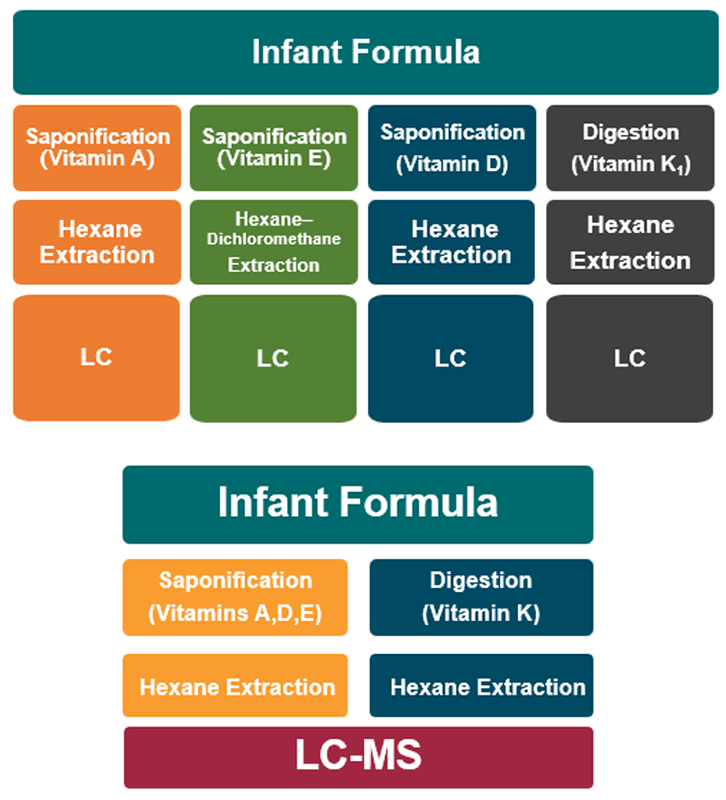 Click to enlarge
Click to enlarge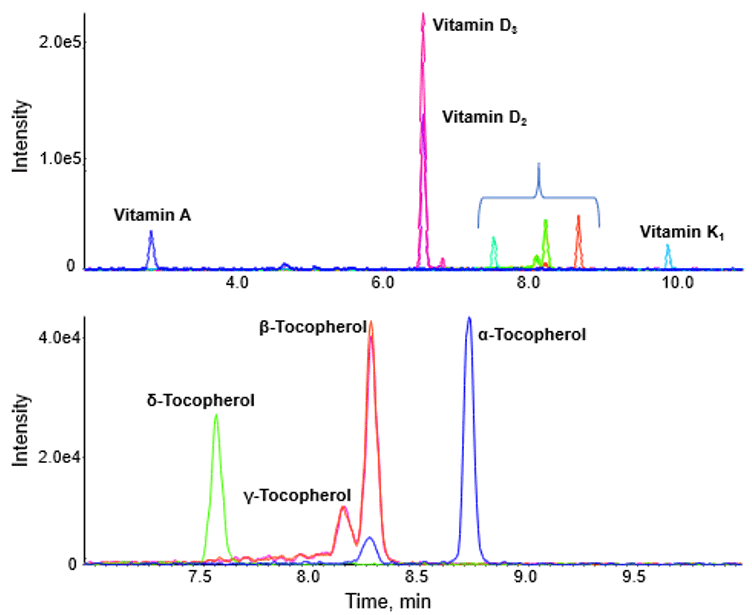 Click to enlarge
Click to enlarge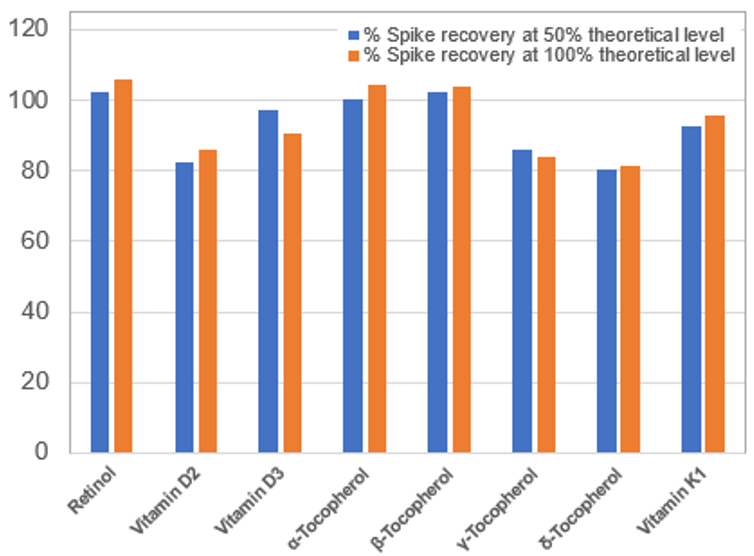 Click to enlarge
Click to enlarge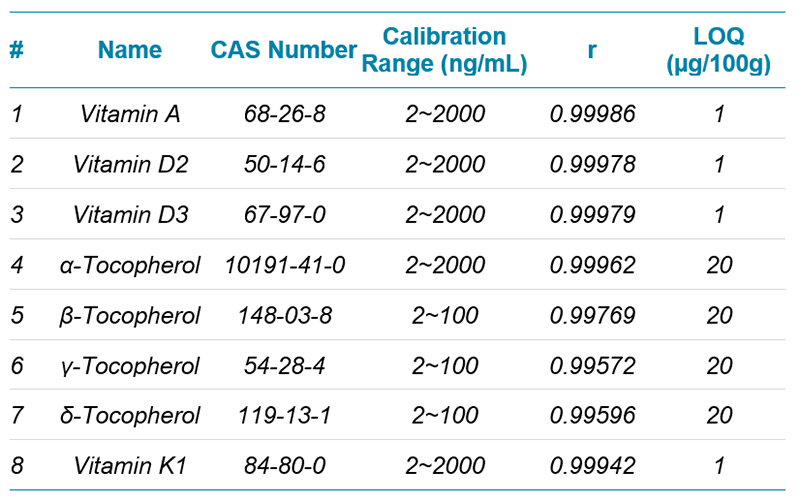 Click to enlarge
Click to enlarge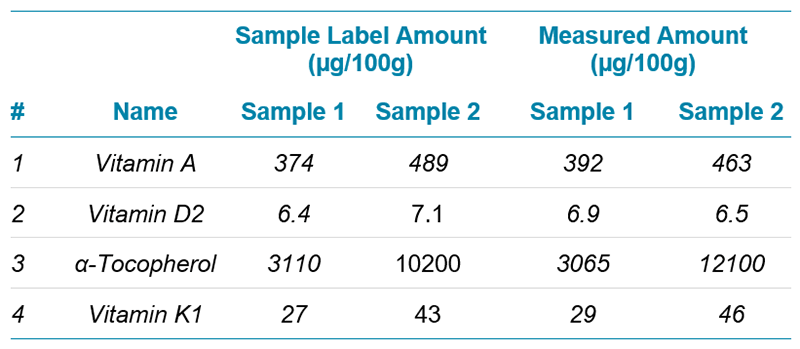 Click to enlarge
Click to enlarge